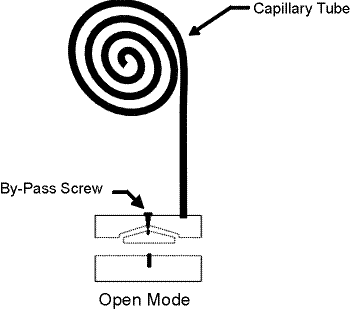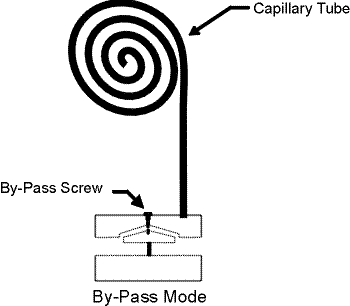Dave's Place
Gas Thermostat
You should read the section on gas safety before attempting any repairs.
All the information below pertaining to gas thermostats also pertain to the gas side of a Combination Thermostat.
The purpose of the gas thermostat is to control the temperature of the refrigerator when it is operating on propane. It does this by controlling the size of the gas flame. The capillary tube (or sensor) of the thermostat is a hollow, sealed tube filled with a gas that expands and contracts with changes in temperature. This movement of the gas inside the tube moves a bellows, which in turn controls the path of the propane through the thermostat.
The end of the capillary tube is positioned at a specific point on the evaporator (usually the fins) of the lower box. When replacing the thermostat be sure to position the capillary tube in the same manner as the old one. Failure to do so may cause inadequate contact, resulting in over cooling.
The thermostats below are drawn for easy understanding and are not mechanically accurate.

|

|
When cooling of the refrigerator is called for, the thermostat merely allows the full flow of propane at 11" water column through to the orifice and burner. See the picture on the left and compare it with the one on the right.
When the desired temperature is reached, the thermostat blocks the "open" pathway and routes the propane through the by-pass section. See above. On most thermostats, a by-pass screw with a very fine hole is installed through the by-pass pathway. Although some older thermostats do use an adjustment screw to control the by-pass flame, the screw mentioned above is not an adjustment screw. The reason for using a screw is that in can be replaced with a different sized screw in case the by-pass flame is not right. NOTE: the by-pass screw is changed entirely too often. If the by-pass screw was the right size for years, it doesn't suddenly become the wrong size. Usually, the only time a by-pass screw needs replacing is on a new installation--and then, rarely.
When the propane is forced through the small hole of the by-pass screw and then into a larger chamber, the output pressure is reduced to between 1 1/2" to 3" water column, depending on the model. Please note this range for low pressures is a range for all models combined; a specific model has a much narrower range for its own low pressure. The lower pressure, or by-pass pressure, coming from the thermostat causes a smaller burner flame designed not to generate cooling from the cooling unit, while still allowing the flame to burn. However, too small a by-pass flame will not heat the thermocouple enough to keep the safety valve open, and the flame will go out.
Troubleshooting
Over Cooling
The thermostat is usually the prime suspect in an over cooling situation but, although it's the culprit
often enough, you shouldn't rush to judgment. The gas thermostat is completely dependent upon the gas
pressure coming into it. The by-pass screw or section is not a regulator, but merely a very small hole
that causes the gas flowing through it to loose pressure. If the input pressure to the refrigerator is
higher than it should be, then the output pressure of a thermostat in by-pass mode will be higher than
it should be. This could cause the cooling unit to continue to cool, even though the thermostat is doing
everything it is supposed to. A good test is to get the refrigerator down to about 40 degrees in the
lower box, and then have someone rotate the gas thermostat knob from one extreme to the other while
you observe the flame. If you can see the flame change noticeably while the knob is being rotated,
that's a good sign that the thermostat is working mechanically and therefore good. A test of the
main gas pressure is needed at this point, but if that is not feasible,
change the regulator, because that is probably what you would end up doing after the pressure test anyway.
No or Poor Cooling
See the section on No Cooling in the Standard Gas Troubleshooting
section. Unless there is some obvious reason not to do so, save replacing the thermostat for the last step.
RV Refrigerator Home
This RV refridgerator information was originally located on rvmobile.comRV Mobile Inc. 11715 HWY 99, Everett, WA 98204
The owner of RV Mobile Inc. apparently suffered a heart attack and the original website was shut down.
It has been reposted here to preserve this wealth of information RV refridgerator information.